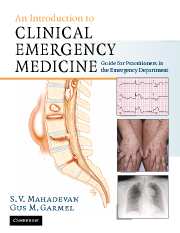Book contents
- Frontmatter
- Contents
- List of contributors
- Foreword
- Acknowledgments
- Dedication
- Section 1 Principles of Emergency Medicine
- Section 2 Primary Complaints
- Section 3 Unique Issues in Emergency Medicine
- 41 Child abuse, elder abuse, intimate partner violence
- 42 Environmental emergencies
- 43 Ethics and end-of-life issues
- 44 Legal aspects of emergency care
- 45 Occupational exposures in the emergency department
- Section 4 Appendices
- Index
42 - Environmental emergencies
Published online by Cambridge University Press: 27 October 2009
- Frontmatter
- Contents
- List of contributors
- Foreword
- Acknowledgments
- Dedication
- Section 1 Principles of Emergency Medicine
- Section 2 Primary Complaints
- Section 3 Unique Issues in Emergency Medicine
- 41 Child abuse, elder abuse, intimate partner violence
- 42 Environmental emergencies
- 43 Ethics and end-of-life issues
- 44 Legal aspects of emergency care
- 45 Occupational exposures in the emergency department
- Section 4 Appendices
- Index
Summary
Scope of the problem
In the US from 1979 to 1995, heat stroke was the stated cause of death in nearly 400 people each year. However, 10 times that number of elderly patients with underlying cardiopulmonary disease are thought to die annually from heat-related complications.
The two major heat illnesses are heat exhaustion and heat stroke.
Heat exhaustion is a syndrome characterized by volume depletion. The core temperature is generally <40.5°C. Mental status is normal.
Heat stroke is a medical emergency characterized by a core temperature >40.5°C and altered mental status.
A number of minor heat illnesses have also been described, including heat cramps, heat edema, heat syncope, heat tetany, and prickly heat. Malignant hyperthermia is characterized by very high core temperature and altered mental status, but is not considered an environmental illness.
Heat cramps are painful muscle cramps which generally occur after exercise in unacclimatized individuals who sweat freely and replace sweat losses with large amounts of water or other hypotonic fluids. Hyponatremia may also occur in this scenario.
Heat edema is a benign condition, most often found in the elderly, in which swelling occurs in the feet and sometimes the hands during the first few days in a hot environment.
Heat syncope is a self-limited condition usually found in unacclimatized persons. Prolonged standing causes venous pooling in the legs which, combined with peripheral vasodilation and volume loss, causes orthostatic hypotension and fainting.
Heat tetany is caused by hyperventilation after brief exposure to intense heat.
[…]
- Type
- Chapter
- Information
- An Introduction to Clinical Emergency MedicineGuide for Practitioners in the Emergency Department, pp. 619 - 652Publisher: Cambridge University PressPrint publication year: 2005



